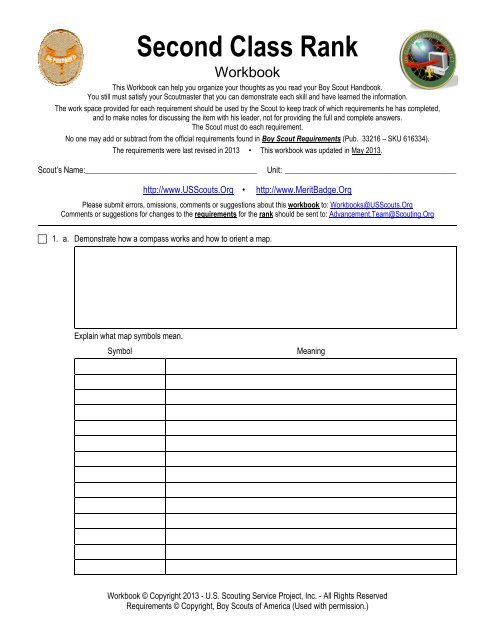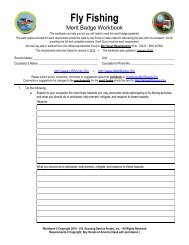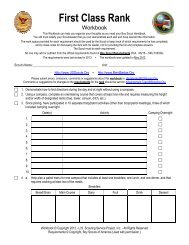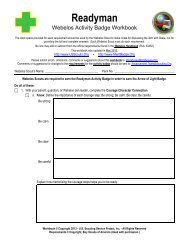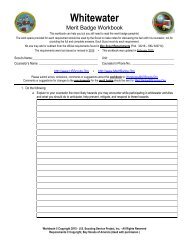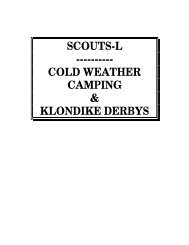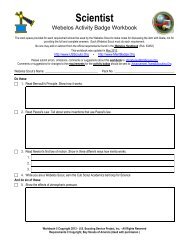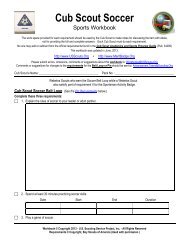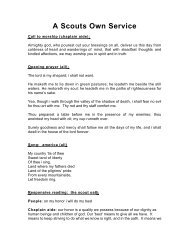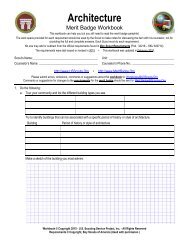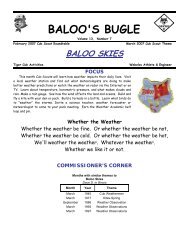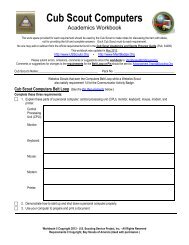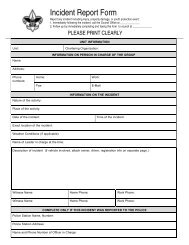Second Class rank Worksheet
Second Class rank Worksheet
Second Class rank Worksheet
You also want an ePaper? Increase the reach of your titles
YUMPU automatically turns print PDFs into web optimized ePapers that Google loves.
<strong>Second</strong> <strong>Class</strong> RankWorkbookThis Workbook can help you organize your thoughts as you read your Boy Scout Handbook.You still must satisfy your Scoutmaster that you can demonstrate each skill and have learned the information.The work space provided for each requirement should be used by the Scout to keep track of which requirements he has completed,and to make notes for discussing the item with his leader, not for providing the full and complete answers.The Scout must do each requirement.No one may add or subtract from the official requirements found in Boy Scout Requirements (Pub. 33216 – SKU 616334).The requirements were last revised in 2013 • This workbook was updated in May 2013.Scout’s Name:__________________________________________Unit: __________________________________________http://www.USScouts.Org • http://www.MeritBadge.OrgPlease submit errors, omissions, comments or suggestions about this workbook to: Workbooks@USScouts.OrgComments or suggestions for changes to the requirements for the <strong>rank</strong> should be sent to: Advancement.Team@Scouting.Org______________________________________________________________________________________________________________________________________________ 1. a.Demonstrate how a compass works and how to orient a map.Explain what map symbols mean.SymbolMeaningWorkbook © Copyright 2013 - U.S. Scouting Service Project, Inc. - All Rights ReservedRequirements © Copyright, Boy Scouts of America (Used with permission.)
<strong>Second</strong> <strong>Class</strong> RankScout's Name: ________________________ b. Using a compass and a map together, take a five-mile hike (or 10 miles by bike) approved by your adult leader andyour parent or guardian. (Note: If you use a wheelchair or crutches, or if it is difficult for you to get around, you maysubstitute "trip" for "hike.")Date:Route: 2. Discuss the principles of Leave No Trace. 3. a.Since joining, have participated in five separate troop/patrol activities (other than troop/patrol meetings), two of whichincluded camping overnight.1. Overnight Camp? 2. Overnight Camp? 3. Overnight Camp? 4. Overnight Camp? 5. Overnight Camp? b. On one of these campouts, select your patrol site and sleep in a tent that you pitched. Explain what factors you shouldconsider when choosing a patrol site and where to pitch a tent. c. Demonstrate proper care, sharpening, and use of the knife, saw, and ax, and describe when they should be used.<strong>Second</strong> <strong>Class</strong> Rank Workbook Page 2 of 9
<strong>Second</strong> <strong>Class</strong> RankScout's Name: ________________________ d. Use the tools listed in requirement 3c to prepare tinder, kindling, and fuel for a cooking fire. e. Explain when it is appropriate to use a cooking fire. At an approved outdoor location and at an approved time, and using the tinder, kindling, and fuel wood fromrequirement 3d, demonstrate how to build a fire; light the fire, unless prohibited by local fire restrictions. After allowing the flames to burn safely for at least two minutes, safely extinguish the flames with minimal impact to thefire site. f. Explain when it is appropriate to use a lightweight stove or propane stove.Set up a lightweight stove or propane stove;Light the stove, unless prohibited by local fire restrictions.Describe the safety procedures for using these types of stoves. g. On one campout, plan and cook one hot breakfast or lunch, selecting foods from the MyPlate food guide or the currentUSDA nutrition model. Explain the importance of good nutrition.<strong>Second</strong> <strong>Class</strong> Rank Workbook Page 3 of 9
<strong>Second</strong> <strong>Class</strong> RankScout's Name: ________________________Tell how to transport, store, and prepare the foods you selected. 4. Participate in a flag ceremony for your school, religious institution, chartered organization, community, or troop activity.Explain to your leader what respect is due the flag of the United States. 5. Participate in approved (minimum of one hour) service project(s).Date:Project: 6. Identify or show evidence of at least 10 kinds of wild animals (birds, mammals, reptiles, fish, mollusks) found in yourcommunity.1.2.3.4.5.6.7.8.9.10.AnimalEvidence<strong>Second</strong> <strong>Class</strong> Rank Workbook Page 4 of 9
<strong>Second</strong> <strong>Class</strong> RankScout's Name: ________________________ 7. a.Show what to do for "hurry" cases of stopped breathing, serious bleeding, and internal poisoning.Stopped breathing:Serious bleeding,Internal poisoning. b. Prepare a personal first-aid kit to take with you on a hike. c. Demonstrate first aid for the following: Object in the eye Bite of a suspectedrabid animal Puncture wounds from a splinter, nail, and fishhookSplinterNailFishhook Serious burns(second-degree)<strong>Second</strong> <strong>Class</strong> Rank Workbook Page 5 of 9
<strong>Second</strong> <strong>Class</strong> RankScout's Name: ________________________ Heat exhaustion Shock Heatstroke, dehydration, hypothermia, and hyperventilationHeatstrokeDehydrationHypothermiaHyperventilation 8. a.Tell what precautions must be taken for a safe swim. b. Demonstrate your ability to jump feet first into water over your head in depth, level off and swim 25 feet on the surface,stop, turn sharply, resume swimming, then return to your starting place. c. Demonstrate water rescue methods by reaching with your arm or leg, by reaching with a suitable object, and bythrowing lines and objects.Explain why swimming rescues should not be attempted when a reaching or throwing rescue is possible, and explainwhy and how a rescue swimmer should avoid contact with the victim.<strong>Second</strong> <strong>Class</strong> Rank Workbook Page 6 of 9
<strong>Second</strong> <strong>Class</strong> RankScout's Name: ________________________ 9. a.Participate in a school, community, or troop program on the dangers of using drugs, alcohol, and tobacco and otherpractices that could be harmful to your health. Discuss your participation in the program with your family, and explainthe dangers of substance addictions. b. Explain the three R's of personal safety and protection.1. R2. R3. R 10. 11.Earn an amount of money agreed upon by you and your parent, then save at least 50 percent of that money.Amount Earned:Amount Saved:Demonstrate Scout spirit by living the Scout Oath (Promise) and Scout Law in your everyday life.Discuss four specific examples (different from those used for Tenderfoot requirement 13) of how you have lived thepoints of the Scout Law in your daily life.1.2.<strong>Second</strong> <strong>Class</strong> Rank Workbook Page 7 of 9
<strong>Second</strong> <strong>Class</strong> RankScout's Name: ________________________3.4. 12. Participate in a Scoutmaster conference. 13. Complete your board of review.Notes:Alternate Requirements for the <strong>Second</strong> <strong>Class</strong> <strong>rank</strong> are available for Scouts with physical or mental disabilities if they meet thecriteria listed in the Boy Scout Requirements book. Click here to learn more, and see the information from the Guide toAdvancement at the end of this workbook.The requirements for Tenderfoot, <strong>Second</strong> <strong>Class</strong>, and First <strong>Class</strong> <strong>rank</strong>s may be worked on simultaneously; however, these<strong>rank</strong>s must be earned in sequence.Requirement resources can be found here:http://www.meritbadge.org/wiki/index.php/<strong>Second</strong> <strong>Class</strong> Rank/#Requirement resources<strong>Second</strong> <strong>Class</strong> Rank Workbook Page 8 of 9
Important excerpts from the Guide To Advancement - 2013, No. 33088 (SKU-618673)[1.0.0.0] — IntroductionThe current edition of the Guide to Advancement is the official source for administering advancement in all Boy Scouts of America programs: CubScouting, Boy Scouting, Varsity Scouting, Venturing, and Sea Scouts. It replaces any previous BSA advancement manuals, including AdvancementCommittee Policies and Procedures, Advancement and Recognition Policies and Procedures, and previous editions of the Guide to Advancement.[Page 2, and 5.0.1.4] — Policy on Unauthorized Changes to Advancement ProgramNo council, committee, district, unit, or individual has the authority to add to, or subtract from, advancement requirements. There are limitedexceptions relating only to youth members with special needs. For details see section 10, “Advancement for Members With Special Needs”.[Page 2] — The “Guide to Safe Scouting” AppliesPolicies and procedures outlined in the Guide to Safe Scouting, No. 34416, apply to all BSA activities, including those related to advancement andEagle Scout service projects.[10.2.2.0] — Advancement for Boy Scouts and Varsity Scouts With DisabilitiesMembers must meet current advancement requirements as written for merit badges, all <strong>rank</strong>s, and Eagle Palms, although some allowablesubstitutions or alternatives are specifically set forth in official literature. The member is expected to meet the requirements—no more and no less—and he is to do exactly what is stated. If it says, “Show or demonstrate,” that is what he must do; just “telling” isn’t enough. The same holds for wordsand phrases such as “make,” “list,” “in the field,” “collect,” “identify,” and “label.” Requests for alternative requirements for Tenderfoot, <strong>Second</strong> <strong>Class</strong>,and First <strong>Class</strong> <strong>rank</strong>s can be made using the information outlined below.It is important to remember that the advancement program is meant to challenge our members; however, not all of them can achieve everything theymight want to—with or without a disability. It is for this reason all Scouts are required to meet the requirements as they are written, with no exceptions.For boards of review for Scouts with special needs, the board members should be informed ahead of time about the special circumstances and needs.It may be helpful, too, if the unit leader is present at the review. He or she may be able to help answer questions and provide background. It may beimportant to allow parents or guardians to be present at the meeting as well—especially if they are able to help interpret and communicate what theScout is saying. At the least, parents should be available to help board members understand the Scout’s challenges and how he copes with them.[10.2.2.1] — Using Alternative RequirementsA degree of modification in advancement requirements may be necessary to mainstream as many members with disabilities as possible. Thus a Scoutwith a permanent physical or mental disability (or a disability expected to last more than two years or beyond the 18th birthday) who is unable tocomplete all the requirements for Tenderfoot, <strong>Second</strong> <strong>Class</strong>, or First <strong>Class</strong> <strong>rank</strong> may, with his parent or guardian, and also the unit leader or a memberof the troop committee, submit a request to the council advancement committee to complete alternative requirements. Unless a Scout has beenapproved to register beyond the age of eligibility, alternative requirements must be completed by the 18th birthday. The procedures appear below.This avenue is also available to youth with longer-term disabilities (such as those related to a severe injury) who want to continue advancing duringrecovery.Simple modifications very close to existing requirement need not be approved. A Scout in a wheelchair, for example, may meet the <strong>Second</strong> <strong>Class</strong>requirement for hiking by “wheeling” to a place of interest. Allowing more time and permitting special aids are also ways leaders can help Scouts withdisabilities make progress. Modifications, however, must provide a very similar challenge and learning experience.Alternatives are not available for the Star, Life, and Eagle <strong>rank</strong> requirements. Scouts may request approval for alternative merit badges, but the otherrequirements for those three <strong>rank</strong>s must be fulfilled as written.The outcomes of the Scouting experience should be fun and educational, and not just relate to completing <strong>rank</strong> requirements that might placeunrealistic expectations on a member who has special needs.[10.2.2.2] — How to Apply for Alternative RequirementsBefore applying for alternative requirements, members must complete as many of the existing requirements as possible. Once they have done theirbest to the limit of their abilities and resources, the unit leader or a troop committee member submits to the council advancement committee a writtenrequest for alternative requirements for Tenderfoot, <strong>Second</strong> <strong>Class</strong>, and First <strong>Class</strong> <strong>rank</strong>s. It must show what has been completed, and suggest thealternatives for those requirements the Scout cannot do.The request must be accompanied by supporting letters from the unit leader, a parent or guardian, and the member (if possible), as well as a writtenstatement from a qualified health professional related to the nature of the disability. This may be, for example, a physician, neurologist, psychiatrist,psychologist, etc., or when appropriate, an educational administrator in special education. Statements must describe the disability; cover the Scout’scapabilities, limitations, and prognosis; and outline what requirements cannot be completed. Additional information such as Individualized EducationPlans provided to parents by schools, and various treatment summariesNormally, it is expected that youth with only moderate learning disabilities, or such disorders as ADD or ADHD can—albeit moreslowly—complete standard requirements.The advancement committee reviews the request, using the expertise of professionals involved with youth who have special needs. To make a fairdetermination, the committee may want to interview the Scout, his parent(s) or guardian(s), and the unit leader. The committee’s decision is thenrecorded and delivered to the Scout and the unit leader.Note that topics 10.2.2.1 and 10.2.2.2 do not apply to merit badge requirements. See topic 10.2.2.3 to learn about earning alternative merit badges tothose required for Eagle.Attachment (NOTE: It is not necessary to print this page.) Page 9 of 9


